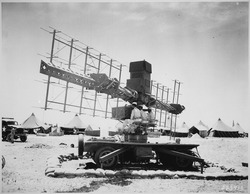| Calf Island Military Reservation | |
|---|---|
| Part of Harbor Defenses of Boston | |
| Hull, Massachusetts | |
 SCR-268 radar in Casablanca, Morocco in WWII | |
| Site information | |
| Type | Coastal Defense |
| Owner | Massachusetts |
| Controlled by | Boston Harbor Islands National Recreation Area |
| Location | |
| Coordinates | 42°20′23.80″N70°53′46.17″W / 42.3399444°N 70.8961583°W |
| Site history | |
| Built | 1941 |
| Built by | United States Army |
| In use | 1941-1946 |
| Battles/wars | World War II |
Calf Island Military Reservation was a World War II coastal defense site located on Calf Island in Hull, Massachusetts.

